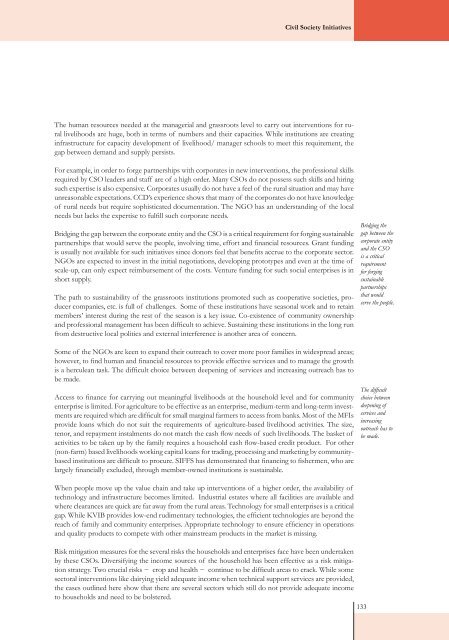SOIL Report 2008 - ACCESS Development Services
SOIL Report 2008 - ACCESS Development Services
SOIL Report 2008 - ACCESS Development Services
Create successful ePaper yourself
Turn your PDF publications into a flip-book with our unique Google optimized e-Paper software.
Civil Society InitiativesThe human resources needed at the managerial and grassroots level to carry out interventions for rurallivelihoods are huge, both in terms of numbers and their capacities. While institutions are creatinginfrastructure for capacity development of livelihood/ manager schools to meet this requirement, thegap between demand and supply persists.For example, in order to forge partnerships with corporates in new interventions, the professional skillsrequired by CSO leaders and staff are of a high order. Many CSOs do not possess such skills and hiringsuch expertise is also expensive. Corporates usually do not have a feel of the rural situation and may haveunreasonable expectations. CCD’s experience shows that many of the corporates do not have knowledgeof rural needs but require sophisticated documentation. The NGO has an understanding of the localneeds but lacks the expertise to fulfill such corporate needs.Bridging the gap between the corporate entity and the CSO is a critical requirement for forging sustainablepartnerships that would serve the people, involving time, effort and financial resources. Grant fundingis usually not available for such initiatives since donors feel that benefits accrue to the corporate sector.NGOs are expected to invest in the initial negotiations, developing prototypes and even at the time ofscale-up, can only expect reimbursement of the costs. Venture funding for such social enterprises is inshort supply.The path to sustainability of the grassroots institutions promoted such as cooperative societies, producercompanies, etc. is full of challenges. Some of these institutions have seasonal work and to retainmembers’ interest during the rest of the season is a key issue. Co-existence of community ownershipand professional management has been difficult to achieve. Sustaining these institutions in the long runfrom destructive local politics and external interference is another area of concern.Some of the NGOs are keen to expand their outreach to cover more poor families in widespread areas;however, to find human and financial resources to provide effective services and to manage the growthis a herculean task. The difficult choice between deepening of services and increasing outreach has tobe made.Access to finance for carrying out meaningful livelihoods at the household level and for communityenterprise is limited. For agriculture to be effective as an enterprise, medium-term and long-term investmentsare required which are difficult for small marginal farmers to access from banks. Most of the MFIsprovide loans which do not suit the requirements of agriculture-based livelihood activities. The size,tenor, and repayment instalments do not match the cash flow needs of such livelihoods. The basket ofactivities to be taken up by the family requires a household cash flow-based credit product. For other(non-farm) based livelihoods working capital loans for trading, processing and marketing by communitybasedinstitutions are difficult to procure. SIFFS has demonstrated that financing to fishermen, who arelargely financially excluded, through member-owned institutions is sustainable.Bridging thegap between thecorporate entityand the CSOis a criticalrequirementfor forgingsustainablepartnershipsthat wouldserve the people.The difficultchoice betweendeepening ofservices andincreasingoutreach has tobe made.When people move up the value chain and take up interventions of a higher order, the availability oftechnology and infrastructure becomes limited. Industrial estates where all facilities are available andwhere clearances are quick are far away from the rural areas. Technology for small enterprises is a criticalgap. While KVIB provides low-end rudimentary technologies, the efficient technologies are beyond thereach of family and community enterprises. Appropriate technology to ensure efficiency in operationsand quality products to compete with other mainstream products in the market is missing.Risk mitigation measures for the several risks the households and enterprises face have been undertakenby these CSOs. Diversifying the income sources of the household has been effective as a risk mitigationstrategy. Two crucial risks − crop and health − continue to be difficult areas to crack. While somesectoral interventions like dairying yield adequate income when technical support services are provided,the cases outlined here show that there are several sectors which still do not provide adequate incometo households and need to be bolstered.133














